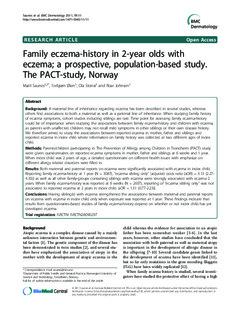| dc.contributor.author | Saunes, Marit | |
| dc.contributor.author | Øien, Torbjørn | |
| dc.contributor.author | Storrø, Ola | |
| dc.contributor.author | Johnsen, Roar | |
| dc.date.accessioned | 2015-09-29T13:06:15Z | |
| dc.date.accessioned | 2015-10-16T11:47:01Z | |
| dc.date.available | 2015-09-29T13:06:15Z | |
| dc.date.available | 2015-10-16T11:47:01Z | |
| dc.date.issued | 2011 | |
| dc.identifier.citation | BMC Dermatology 2011, 11 | nb_NO |
| dc.identifier.issn | 1471-5945 | |
| dc.identifier.uri | http://hdl.handle.net/11250/2356370 | |
| dc.description.abstract | Background: A maternal line of inheritance regarding eczema has been described in several studies, whereas
others find associations to both a maternal as well as a paternal line of inheritance. When studying family history
of eczema symptoms, cohort studies including siblings are rare. Time point for assessing family eczema-history
could be of importance when studying the associations between family eczema-history and children with eczema,
as parents with unaffected children may not recall mild symptoms in other siblings or their own disease history.
We therefore aimed to study the associations between reported eczema in mother, father and siblings and
reported eczema in index child where information on family history was collected at two different ages of index
child.
Methods: Parents/children participating in The Prevention of Allergy among Children in Trondheim (PACT) study
were given questionnaires on reported eczema symptoms in mother, father and siblings at 6 weeks and 1 year.
When index child was 2 years of age, a detailed questionnaire on different health issues with emphasize on
different allergy related disorders were filled in.
Results: Both maternal and paternal reports on eczema were significantly associated with eczema in index child.
Reporting family eczema-history at 1 year (N = 3087), “eczema sibling only” [adjusted odds ratio (aOR) = 3.13 (2.27-
4.33)] as well as all other family-groups containing siblings with eczema were strongly associated with eczema 2
years. When family eczema-history was reported at 6 weeks (N = 2657), reporting of “eczema sibling only” was not
associated to reported eczema at 2 years in index child [aOR = 1.31 (0.77-2.23)].
Conclusions: Having sibling(s) with eczema strengthened the associations between maternal and paternal reports
on eczema with eczema in index child only when exposure was reported at 1 year. These findings indicate that
results from questionnaires-based studies of family eczema-history depend on whether or not index child has yet
developed eczema. | nb_NO |
| dc.language.iso | eng | nb_NO |
| dc.publisher | BioMed Central | nb_NO |
| dc.title | Family eczema-history in 2-year olds with eczema; a prospective, population-based study. The PACT-study, Norway | nb_NO |
| dc.type | Journal article | nb_NO |
| dc.type | Peer reviewed | en_GB |
| dc.date.updated | 2015-09-29T13:06:15Z | |
| dc.source.volume | 11 | nb_NO |
| dc.source.journal | BMC Dermatology | nb_NO |
| dc.identifier.doi | 10.1186/1471-5945-11-11 | |
| dc.identifier.cristin | 875195 | |
| dc.description.localcode | © 2011 Saunes et al; licensee BioMed Central Ltd. This is an Open Access article distributed under the terms of the Creative Commons Attribution License (http://creativecommons.org/licenses/by/2.0), which permits unrestricted use, distribution, and reproduction in any medium, provided the original work is properly cited. | nb_NO |
